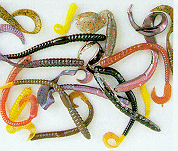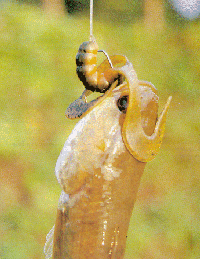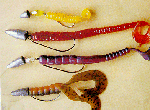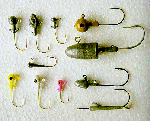
Articles about fishing experiences in Malaysia
 |
Articles
Articles about fishing experiences in Malaysia |
 Soft Plastics
Soft Plastics
by Chris Tan Plastics: they are appearing every where in our fishing. We have reels, rod components, floats, lures and other fishing related accessories made of plastic. Gone are the days when metals, wood and other natural materials were used to construct our fishing equipment. One fishing item made from plastic is the soft plastic lure. Most people mistake these lures to be made of rubber, but they are in general made of synthetic materials like soft plastic. The soft plastic lures are used to catch a whole range of fish, from the esteemed salt water marlin down to the common local tilapia. Of course the lures come in all shapes, sizes and colours. A personal experience My first experience with soft plastics was a packet of flavoured worms a friend bought for me from the U.S.A. six years ago. I thought they were to be used like our live worms. I hooked one up on a ledgering rig and threw it into a river in the Kelantan jungle, hoping to catch a big baung. Well, I certainly wasted my time! I know better now! The techniques used for these soft plastic lures are in many ways similar to the other hard plastic lures. The upper end of the range includes plastic lures used for large pelagic fish like marlin, sailfish and tuna. They are basically skirts, which resemble octopus, squid or cuttlefish. I have cut open thirty pound barracuda and found squid eight inches long in the guts, almost the same size as the skirts! The hard head skirts are the most commonly used ones. They can be trolled on or below the surface depending on the shape of the head. There are those that run below the surface, coming up every ten to twenty seconds leaving a bubble trail. The ones with jet heads, run just at the surface leaving a continuous big bubble trail. One major advantage of skirts over the minnow lure is that they can be trolled at high speeds, some models up to twenty knots! The rigging for these lures is simple. Either a double hook or single hooks can be used. I personally prefer single hooks, as they are harder for the fish to lever out. On the larger lures the single hooks can be rigged in tandem, with either a ninety degree or hundred and eighty degree offset. Use of wire is a must in our equatorial/tropical waters, due to our numerous toothy critters! I found out the hard way that even very, very hard 200lb mono is no match for the teeth of our local fish! However in general a 50lb to 100lb wire is sufficient.Some of the fish caught on these lures in Malaysian waters are marlin, sailfish, tenggiri, wahoo, barracuda, cobia and giant trevally. Smaller saltwater fish can be caught around reefs or rocks with soft plastic jigs. Jigging and casting are the general techniques used. I have even caught baby tarpon in mangrove areas with a tiny soft plastic imitation tadpole! A friend of mine was catching queen-fish on grub like soft plastics near Port Dickson not long ago.  Soft plastics are
particularly useful for fishing haruan. Picture this, you have had your
last frog chewed up by a cunning haruan and you are out in the middle of
nowhere. The haruan are rising all around you among the weeds and the
aquatic growth is too thick for even weedless spoons and spinnerbait! You
pull out a soft plastic worm. What else!
Soft plastics are
particularly useful for fishing haruan. Picture this, you have had your
last frog chewed up by a cunning haruan and you are out in the middle of
nowhere. The haruan are rising all around you among the weeds and the
aquatic growth is too thick for even weedless spoons and spinnerbait! You
pull out a soft plastic worm. What else!
You decide to rig it up Texas style. Sliding a small bullet sinker on to the line, to assist in the cast, you tie on a hook. The bullet shaped weight will help the plastic worm slide unhindered through the thick cover. Pierce the head of the worm with the hook and bring it out the side a quarter inch down. The hook is then reversed and impaled back into the worm. The point of the worm remains buried to make it weedless. You carefully cast to a likely spot. Carefully pulling the plastic worm through the thick cover, it slides easily among the grass patches. Just as you let it sink into a hole, a gentle bump is felt. Immediately, taking in the slight slack, you lift the rod tip firmly to get the point of hook to penetrate through the plastic and set into the jaw of the haruan. The rod bucks in your hands and you see the water boil with mud anddebris, churned up by the haruan. In less than a minute you are admiring your catch! Sometimes the bite can be a jarring hit with an immediate self hook-up. At other times the bite is not felt. The fish swims toward you with the plastic worm in its mouth. Only by your vigilance, you realise the line is not behaving normally. You strike without delay before the fish drops the artificial worm. At other times the bite is felt as a light tap or a staccato of taps.  The Texas Rig
The Texas Rig
The Texas rig is used when the plastic lure is to be fished deep among structure or along the bottom over tree trunks, branches, rocks and other snaggy bottoms. The bullet weight is allowed to slide freely. It lets the fish take the lure in its mouth without feeling any hard object, thus it will hold the lure longer. If the weight is pegged (use a tooth-pick, pegging the mono line against the bullet weight) against the head of the worm, it will help it slide readily through thick cover. The disadvantage is, the fish will feel the weight and would probably drop the soft plastic worm quickly. Always use the lightest possible sinker to cast effectively. The soft plastic lure can be used without weights. The sinking soft plastic lure can be slowly twitched just below the surface. Stop the retrieve and then it will slowly sink. Keep the line tight and watch for any possible takes. Quite often the fish will take the lure on the fall and spit it out without pulling on the line. The only indication would be the line indicating that the lure has stopped its fall before reaching the bottom. The Carolina Rig Another common rig is the Carolina rig. Slide a weight on the mainline and tie on a swivel. Have about two feet of line between the swivel and the hook and a floating worm. This rig is suitable for muddy or weed bottoms where the Texas rig would be constantly buried in the muck. By using a floating worm, the sinker will drag along the bottom and the floating worm will be above the bottom in clear view of the fish. Notice that most fish, like haruan, have their eyes situated on the upper part of the head. They cannot see below them at close range. Only bottom feeders like patin have their eyes located where they can see below. Normally most fish will not attack lures passing below them. Personally I like worms with dark colours. However I have heard of chaps who swear by white ones. The colours they come in are limitless. Two tone coloured worms are common too. A common rule of thumb is to use dark lures in dark waters or dark lighting conditions, and light coloured lures in clear water or bright light. Quite a few soft plastic lure makers provide scented or flavoured lures, but naturally they cost more! These flavoured or scented soft plastics have been found to keep the fish holding on a little longer than ones without flavour or scent. This can be important in giving the angler sufficient time to be aware that a fish is holding the lure and to set the hook. These soft plastic worms are also effective on other local fish like toman and sebarau. Even really small grub like soft plastics can catch our numerous tilapia. The advantage of soft plastic lures over the hard lures like spoons, spinners and plugs/minnows, is that plastic worms are about the only artificial lures that can be used around brush and submerged trees without getting snagged. That means the lure goes in where the fish are holding, within the striking range of the fish. Whereas, lures with exposed hooks, swim out of range in the clear water. At a cost of less than ringgit each, even if a dozen were lost it would be nothing compared to losing a dozen hard lures costing between ten to twenty ringgit each!  A variety of designs
A variety of designs
Worm lures come in many designs. Solid worms, worms with thin flat tails, twin tails and paddle tails are hot designs. Worms with tails or paddles have a fluttering action when retrieved. In fact some of the twin tail worms have an action a lot like a frog, with the twin tails fluttering like legs. The solid worms will undulate slowly when retrieved in short slow pulls. The vibrations emitted by soft plastics is negligible compared to the other hard lures, which emit strong vibrations that can even be felt at the rod! These softer lures may be advantageous when trying to get the fish to hit the lure, as the action is not as violent or loud so as to scare timid or cautious fish. In clear water it is better to use smaller lures, but when it is murky the larger lures give off stronger signals for the fish to home in on. To make the soft plastic noisier, use two small weights instead of one big one. The two weights will click against each other. Using a bead between the weight and the worm will create noise too. There are little rattlers that can be slipped on the line or into the lure to generate noise. Plastic worms are not the only soft lures. There are many different food imitations available. Bait-fish shaped soft plastics are popular. Shrimp, frogs, lizards and crawfish are other common moulds. I have found the bait-fish imitations quite effective. The colours that are more natural like grey with silver flecks are constant producers. For thickly covered waters, the slim form of the worm is the easiest to fish with. Fish have moods, so a change of the sizes or colours of the plastics may be required if the fish are not biting. If a four inch worm is not getting hits, try a six inch worm instead. If the brown worm is still untouched, maybe a fluorescent red might draw more attention! Change the type of lure, if the slim worm is not working, a bulky crawfish might change your prey's mind! The containers used to store the soft plastic lures is critical. Use the wrong type of plastic box and you will find a goey mess in a few days. The different sorts of plastic react together, forming a sticky soft mess! It will also eat through the plastic! Use plastic boxes that are worm-proof. The well known brands like plano or flambeau make them. They are normally clear or opaque white. Local tackle shop owners should be able to advise you. Storing the soft plastic lures in plastic bags is an alternative, the plastic bags are worm-proof. If soft plastic lures of different colours are stored together, the colours will leach into the lures in contact with each other. If you want the colour of the lures to remain original, do store them separately! Getting a variety of these products locally can be quite frustrating. Previously I had been getting my soft plastics from Japan and U.S.A., but recently I discovered that Tightlines in Bandar Sunway has quite a good variety of these artificial soft plastic lures and hooks. Good hunting! |